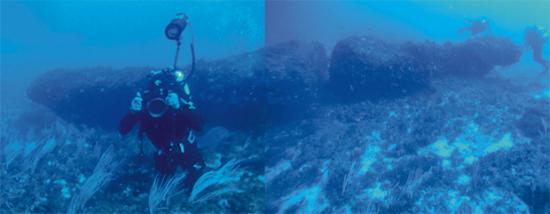Underwater ‘Stonehenge’ Monolith Found Off the Coast of Sicily, sits on the 37th Parallel !
I get asked all the time if I know of important locations outside the USA which fall on the 37th latitude or the Paranormal Highway (aka 37th Parallel). So I’ve promised if I hear of anything, I would update the website readers. Besides Athens, Greece and the Gobekli Tepe temple in Turkey resting on the 37th Parallel, this unusual Stonehenge-type monolith popped up in recent news which also lies on the Parallel. Found 24 miles north of the volcanic island of Pantelleria it was submerged during a massive flood close to 10,000 years ago.
– Information taken from Discover News article, written Aug 6, 2015 04:50 PM ET // Image: Credit: Emanuele Lodolo
Archaeologists have discovered a mysterious Stonehenge-style monolith in the deep sea off the coast of Sicily, shedding new light on the earliest civilizations in the Mediterranean basin.
Broken in two parts, the 3.2-foot-long monolith has a rather regular shape and features three holes of similar diameter. One, which can be found at its end, crosses it completely from part to part, the others appear at two sides of the massive stone.
Such features leave no doubt that the monolith was man-made some 10,000 years ago.
“There are no reasonable known natural processes that may produce these elements,” Zvi Ben-Avraham, from the Department of Earth Sciences at Tel Aviv University, and Emanuele Lodolo, from the National Institute of Oceanography and Experimental Geophysics in Trieste, Italy, wrote in the Journal of Archaeological Science.
The monolith was found at a depth of 131 feet, on what was once an island in the Sicilian Channel. Called Pantelleria Vecchia Bank, the island was located some 24 miles north of the volcanic island of Pantelleria and was submerged during a massive flood about 9,500 years ago.
Indeed, the entire geography of the Mediterranean Basin was radically altered by the increase in sea level following the Last Glacial Maximum.
“The Sicilian Channel is one of the shallow shelves of the central Mediterranean region where the consequences of changing sea-level were most dramatic and intense,” the researchers wrote.
During the Last Glacial Maximum, the Adventure Plateau — the shallowest, north-western sector of the Sicilian Channel — was connected to Sicily, forming a broad peninsula that was separated from the North African coastline by about 30 miles.
“The gradual increase of the sea level caused the flooding of most of the peninsula, with the exception of some morphological highs that, until at least the Early Holocene, formed an archipelago of several islands separated by stretches of extremely shallow sea,” the researchers said.
One of those islands was the Pantelleria Vecchia Bank, where the massive monolith was found and where an ancient civilization thrived. These ancient people possibly colonized and settled the various islands of the archipelago, attracted by a suitable climate and a geographical position between Europe and Africa.
Everything ended about 9,500 years ago, when, according to the post-glacial curve of sea-level change for the Italian coasts, seawater submerged Pantelleria Vecchia Bank.
“This discovery reveals the technological innovation and development achieved by the Mesolithic inhabitants in the Sicilian Channel region,” Lodolo told Discovery News.
He noted that the monolith, which weights about 15 tons, was made of a single, large block that required cutting, extraction, transportation and installation.
“Such an effort undoubtedly reveals important technical skills and great engineering,” Lodolo said.
It is not known what the monolith’s fuction was or whether it was part of a large complex.
“Most likely the structure was functional to the settlement. These people were used to fishing and trading with the neighboring islands,” Lodolo said.
“It could have been some sort of a lighthouse or an anchoring system, for example,” he added.
The most famous archaeological discovery of Mesolithic age is the monumental temple complex of Göbekli Tepe, in south-eastern Turkey. Excavated by a German team in the 1960s, the site has been dated to about 11,600 years ago and is believed to have been a religious center or sanctuary serving a well-organized settlement.
“Almost everything that we do know about prehistoric cultures derives from settlements that are now on land. On the contrary, an extensive archaeological record of early settlings lies on the sea-floor of our continental shelves,” Lodolo said.
“If we want to trace the origins of civilization in the Mediterranean region, we must focus on the now-submerged shelf areas,” he added.
Thank you Discovery News…
Category: In the News, The Z-Files










